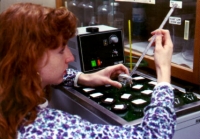IASR is a world leader in studies of the thermodynamics and kinetics of surfactant precipitation. Precipitation of surfactant can often dramatically decrease the effectiveness of a formulation. The surfactant which is precipitated from solution is not available to perform its other functions such as wetting, foaming, emulsification, solubilization, soil removal, and antiredeposition to name a few. The precipitate itself can be deleterious, as encrustation on fabric in laundry detergency for example. Recent project include measurement of the rate of dissolution of soap scum and determination/modeling of phase boundaries of anionic/zwitterionic surfactant mixtures.
Consumer Products

The solubilization of oily soils by micelles can be an important phenomenon in detergency. Solubilization is a valuable tool in reducing the partial pressure of VOC's (volatile organic carbons) in such products as hard surface cleaners. Solubilization can reduce the partial pressure of perfumes over a surfactant solution. We have developed methods to accurately measure solubilization of these kinds of compounds

Adsorption of surfactant onto soils in clothes washing can be an important factor in their detachment from cloth and subsequent removal. The adsorption of surfactant onto solids is of obvious importance in hard-surface cleaning. Research to measure adsorption of surfactants on various surfaces is an extremely active program at IASR. The goals are to understand the forces causing adsorption and to quantify the factors enhancing or reducing adsorption. Our ability to predict the effect of changing surfactant structure in single surfactant systems or changing surfactant composition in mixed surfactant systems on adsorption is continually being improved. Ultimately, this knowledge can be used with other detergency studies to design optimum detergent formulations.

Microemulsions are of growing industrial interest as an increasing number of consumer products are microemulsion-based systems. Significant research advances in our laboratories over the past 20 years have greatly increased our ability to form microemulsions under a wide range of conditions. Through the clever use of surfactant mixtures with a wide range of HLB values, we have been able to micromulsify a wide range of oils. And using a new generation of surfactants known as extended surfactants we have been able to microemulsify triglyceride oils at ambient conditions and without alcohol addition – to our knowledge this is a first. We have also made significant progress in the development of quantitative tools to formulate microemulsion systems for specific situations. For example, our zero curvature model allows us to describe microemulsion properties important to product formulation. And all of these studies have investigated a wide range of oils, including vegetable oils, motor oil, chlorinated hydrocarbons, diesel fuel, gasoline, triglycerides, and cutting oils.
We have applied our knowledge of the phenomena important in surfactant behavior to design of cleaning systems. We have formulated laundry detergents based on microemulsions which can more effective as a pretreatment or as a primary laundry detergent than leading commercial brands. Issues are the robustness of a formulation designed for a specified oil to other oils present, achieving high solubilization at low salinities, and avoiding other nasty phase formation like precipitate or liquid crystals.
Soap scum dissolution in hard surface cleaners has been studied with an eye to understanding basic mechanisms like the role of surfactant vs. chelating agent in dissolving calcium stearate for example. Both kinetic and thermodynamic studies have been preformed, as well as scrub tests to combine fundamental understanding with practical results to improve formulations in this application.
Recent research has focused on developing improved cleaning systems for cold water detergency of semi-solid waxy soils (e.g., triglycerides / vegetable oils below their melting point).
